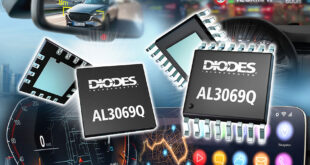Toshiba will start sampling the TB9033FTG, a Clock Extension Peripheral Interface (CXPI) responder interface IC with built-in hardware logic.
The hardware logic can control the data communication by the CXPI protocol and General Purpose Input/Output (GPIO), eliminating the need for dedicated software development thereby shortening development times.
The new product enables multiplexing of automotive communications and reduces the number of wire harnesses used in body control system applications, contributing to the reduction of vehicle weight. Compared to the Local Interconnect Network (LIN) protocol, the high-speed response of the CXPI responder interface device makes it suitable for applications including steering wheel switches, meter cluster switches, light switches, and door locks and mirrors.
The device has 16 GPIO pins – six of them can be switched to one circuit of 10bit AD converter input, and four pins can be switched to four circuits of 8bit PWM (Pulse Width Modulation) output. The device is also equipped with an input monitoring function during sleep mode, a switch matrix (max. 4×4) input function, and an output function in the event of communication disruption.
This device’s standby current consumption is only 10µA, indicating that it draws minimal power while in sleep mode. Low electromagnetic interference (EMI) and high electromagnetic susceptibility (EMS), mean less noise is generated, which eases system design. In addition, the device’s high electrostatic discharge (ESD) characteristic makes it highly resistant to static electricity.
The TB9033FTG includes fault detection circuits for overtemperature, overvoltage, and low voltage. In addition, the device can predict fault conditions and automatically alert the commander node, contributing to improved fault detection performance. The operating temperature range of the device is from -40 to 125°C, and it will conform to the AEC-Q100 standard.
Toshiba is also developing an automotive CXPI communication driver receiver IC that can be switched between the commander and responder node via an external pin.
 Engineer News Network The ultimate online news and information resource for today’s engineer
Engineer News Network The ultimate online news and information resource for today’s engineer





